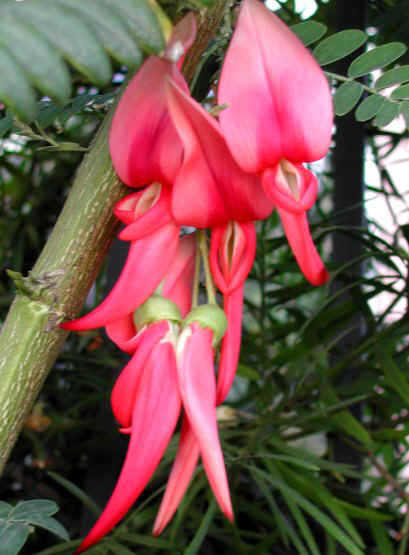Clianthus puniceus
Germinating the seeds Your seeds might have some white fluff around them. It is not mold - it's the natural "packing material" produced in the seed pod. :-) Pre-treatment -- Rub each seed over coarse sandpaper or a nail file for a few seconds to scratch the hard seed coat, so water can enter easier. Next soak the seeds in 2-4 ounces (60-120mL) of warm water, and leave it at room temperature for 24 hours. The seeds will expand to about twice their size. After 24 hours, if any seeds don't swell up, repeat the sandpaper treatment, but soak them in hot water (not hot enough to burn you). You can repeat the treatment again after 24 hours using hotter water. If any seeds don't plump up after the third treatment, plant them anyway. Planting the seeds -- You may
plant each seed in individual, small containers, such as seedling starter trays For soil, use a well draining
mix. A typical mix is 2 parts quality potting soil Fill the pots with the soil mix, place a seed on top, cover with 1/4 inch (6 mm) of soil, and water until evenly moist. If you enclose the pots in plastic container to maintain moisture, leave it open slightly to prevent stem rot later. They germinate well between
about 65 to 77 degrees F (18-25°C). A little cooler at night is ok.
Avoid letting them get above 80° F (27°C) for prolonged periods. I recommend placing a
minimum/maximum thermometer Most of the seeds should sprout within 3-4 weeks, but allow up to 8 weeks for any slow ones, especially at cooler temperatures. Once they sprout, give them bright light, but protect them from strong direct sun the first 2 months (See: "Growing indoors with LED lights"). For the first few months, i recommend keeping them above 55 degrees F (13°C) and below 82°F (28°C). Growing on -- Repot to larger containers when they are about 2 months old. Water the soil before repotting, to keep the soil ball from breaking apart, which can damage the delicate roots. The first week after repotting, shade from sun and give no fertilizer. Fertilizing -- The first 6 weeks, feed every 2 weeks with a small amount of dilute (1/8 strength) liquid fertilizer. Hydroponic fertilizer is ideal for young seedlings, since it is easily absorbed and contains all essential nutrients. After 6 weeks, you may switch to a granular fertilizer that contains micronutrients, feeding at half the dosage on the package. Growing onward.. Climate -- It does best with temperatures above freezing, although mature plants reportedly can survive brief dips down to 22 degrees F (-5°C), although the foliage will likely die. If you are not in Zones 8b through 11, you may grow it in a pot and move it indoors for the winter, pruning it to any size that is convenient. It prefers mostly sunny conditions, although some afternoon shade may be needed in warmer areas. The plant is happiest below 85 degrees (29°C) and might lag in consistently hot summers with warm nights. The usually grows more horizontally than vertically, but feel free to train the branches more upright if you prefer, tying them to stakes or a trellis. When the plant blooms, the flowers will dangle down, creating a spectacular effect. Pests to watch for - If slugs & snails are a problem in your area, make sure to bait for them regularly, or keep the plant in a hanging planter. Watch for any insects that can affect your other plants. Have fun growing them! - Jeff Strange Wonderful Things
|
|||||||||


